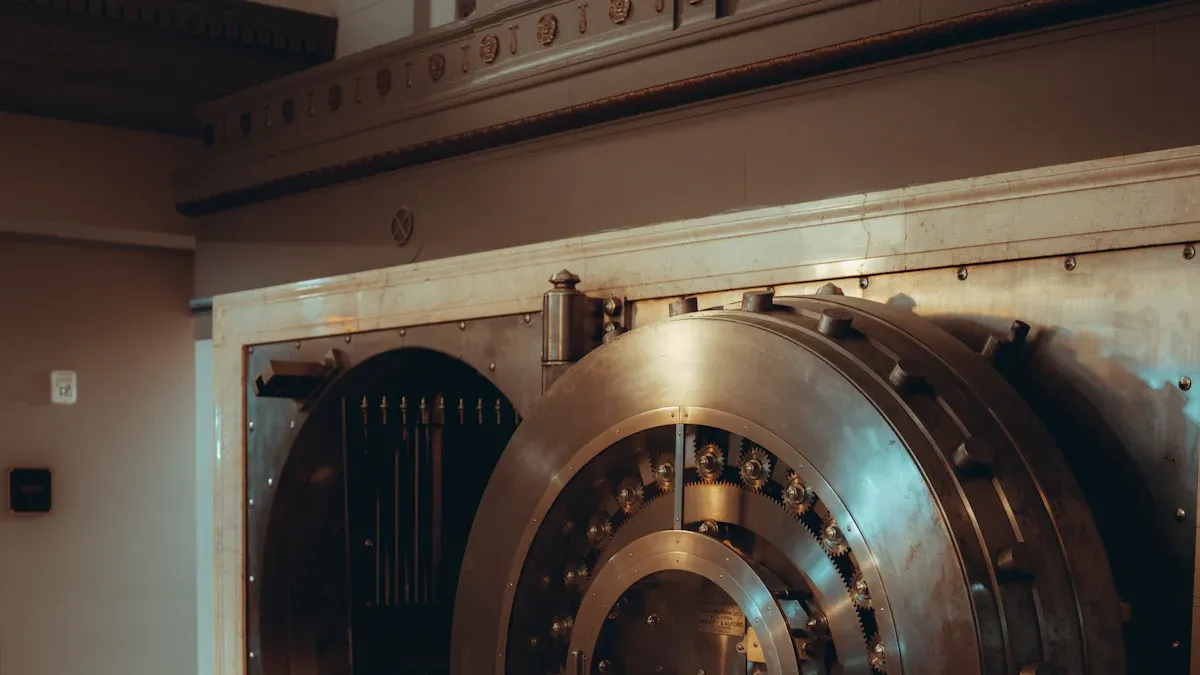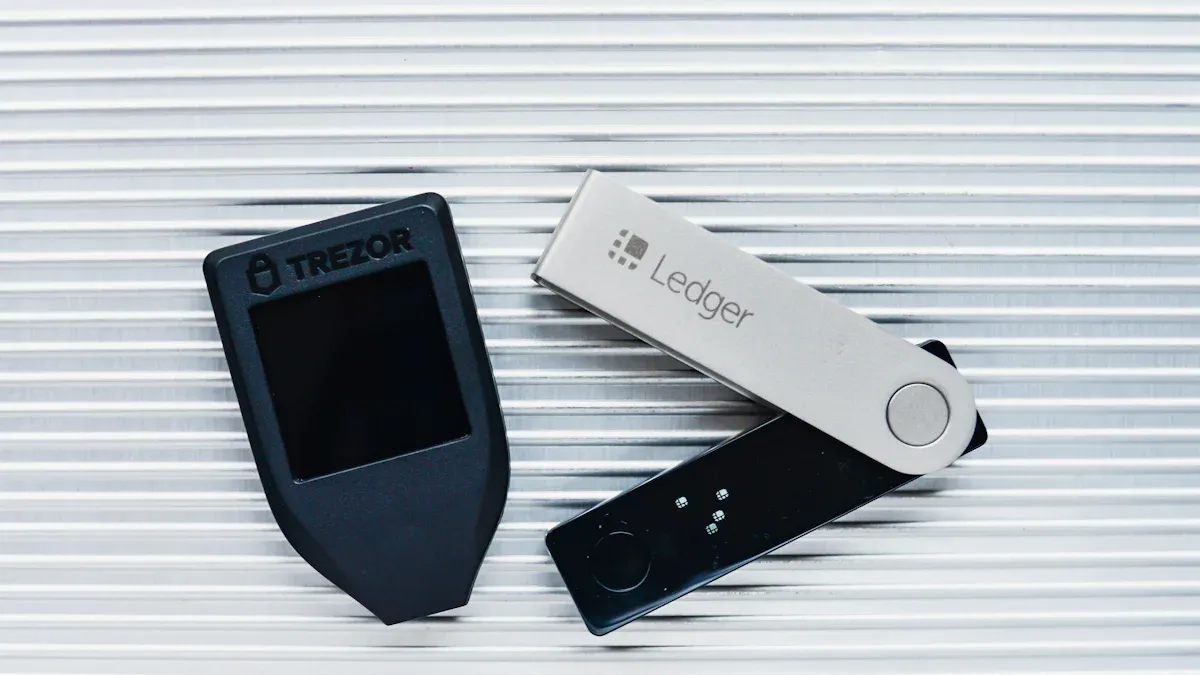Where is Cryptocurrency Stored in 2025 and What Are the Storage Options
2025-07-04 00:00:00
Cryptocurrency exists as digital assets on the blockchain, not as coins or bills. People access these assets using wallets that store private keys. These private keys control ownership and allow users to send or receive cryptocurrency. In 2025, the question "where is cryptocurrency stored" matters more than ever. The global market for digital assets reached $3 trillion in 2021, and projected revenue stands at $85.7 billion in 2025.
Wallets play a critical role in security and control. Studies from 2023 to 2025 show wallet security depends on strong cryptographic methods and defense against brute-force attacks. Many modern crypto wallet options now use AI and biometric tools for better storage and security. Choosing the right wallet gives users both convenience and peace of mind.
Key Takeaways
- Cryptocurrency exists only as data on the blockchain, and wallets store private keys that control access to these digital assets.
- Private keys are crucial for security; losing them means losing access to your cryptocurrency, so always back up and protect your keys carefully.
- Different wallet types offer various balances of security, control, and convenience—cold wallets provide the highest security, while hot and custodial wallets offer easier access but more risks.
Where is Cryptocurrency Stored

Blockchain and Digital Assets
Cryptocurrency does not exist as coins or bills. Instead, it lives as data on a blockchain. The blockchain acts as a digital ledger that records every transaction and ownership change. When someone asks, "where is cryptocurrency stored," the answer points to this distributed ledger. Each digital asset, such as Bitcoin or Ethereum, appears as a token on the blockchain. These tokens represent value but have no physical form.
- Real-world assets and cryptocurrencies appear as digital tokens on blockchains.
- Smart contracts automate and secure the ownership and transfer of these assets.
- Cryptocurrencies exist as data entries on distributed ledgers, not as physical coins.
- Tokenized assets, including cryptocurrencies, are managed entirely through blockchain data and smart contract logic.
- The blockchain serves as a decentralized and immutable ledger, recording ownership and transactions.
Traditional cryptocurrencies like Bitcoin and Ethereum exist only as records on public blockchain ledgers. They have no physical backing. Researchers classify these assets as purely digital and intangible. This fact shapes every cryptocurrency storage solution.
Quantitative research highlights the evolution of digital asset storage. For example, 76% of studies focus on security, privacy, and performance challenges. Privacy concerns increased by 74% from 2020 to 2021. The use of encryption in privacy studies reached 25% in recent years. These trends show that as digital assets grow, so does the need for secure and private storage.
| Aspect / Metric | Statistic / Trend | Timeframe / Notes |
|---|---|---|
| Security, privacy, and performance challenges | 76% of studied problems | Overall in reviewed literature |
| Increase in privacy concerns | 74% relative increase (from 8.4% to 14.6%) | 2020 to 2021 |
| Use of encryption in privacy studies | 25% of privacy studies | Recent years |
| Proof of Work consensus usage | Declined to below 38% | By 2022 |
| Permissioned blockchain usage | 75% of reviewed studies | Recent years |
Role of Private Keys
Private keys play a central role in cryptocurrency storage. A private key is a long string of numbers and letters. It acts like a secret password that unlocks access to digital assets on the blockchain. When someone owns cryptocurrency, they control it through their private keys. Without the correct private key, no one can move or spend those assets.
Private keys are the only way to prove ownership and authorize transactions on the blockchain.
The importance of private keys becomes clear when looking at real-world cases. In the Mt. Gox attack, hackers stole 850,000 Bitcoin because of poor private key management. This event shows that weak security can lead to massive losses. Security testing has improved since then. Cryptographic resistance increased by 95%, and phishing attacks dropped by 85%. Many users now protect their private keys with hardware wallets, two-factor authentication, and secure backups. Exchanges also use cold storage and multi-signature approval to keep private keys safe.
| Evidence Type | Description | Quantitative Data / Example |
|---|---|---|
| Case Study | Mt. Gox Attack illustrating consequences of poor private key management | Theft of 850,000 Bitcoin due to key management failures |
| Security Performance | Cryptographic resistance and phishing attack reduction from security testing | 95% increase in cryptographic resistance; 85% reduction in phishing success |
| User Security Measures | Recommended personal security practices for private key protection | Use of hardware wallets, two-factor authentication, secure backups |
| Organizational Measures | Exchange-level security frameworks to protect private keys | Cold storage of 95% assets offline; multi-signature for transaction approval |
Crypto Wallet Basics
A wallet is a tool that stores private keys and helps users manage their cryptocurrency. Wallets do not hold the coins themselves. Instead, they store the information needed to access and control digital assets on the blockchain. When someone asks, "where is cryptocurrency stored," the answer involves both the blockchain and the wallet.
Crypto wallets come in many forms. Some wallets are software programs on computers or phones. Others are hardware devices that keep private keys offline. There are also paper wallets, which store keys on printed sheets. Each type of wallet offers different levels of security, control, and convenience.
- Software wallets are easy to use and offer quick access.
- Hardware wallets provide strong security by keeping private keys offline.
- Paper wallets are simple but can be lost or damaged.
Decentralized wallets give users full control over their private keys. These wallets do not rely on third parties. Non-custodial wallets are a type of decentralized wallet. They let users manage their own security and backups. Custodial wallets, on the other hand, store private keys for users. These wallets offer convenience but require trust in the provider.
Crypto wallets have become more advanced in 2025. Many now use biometric authentication and artificial intelligence to boost security. Decentralized wallets and non-custodial options remain popular for those who want full control. Custodial wallets attract users who prefer ease of use and support. The choice of wallet affects how users interact with the blockchain and protect their assets.
Tip: Always back up your wallet and keep private keys in a safe place. Losing access to private keys means losing access to cryptocurrency.
Wallet Storage Options

Custodial Wallets
Custodial wallets store cryptocurrency for users. A company or exchange controls the private keys and manages wallet security. Many institutions choose custodial wallets because they offer legal protection, insurance, and strong security measures. BitGo and Anchorage Digital are popular custodial wallets. These wallets use multi-signature approval, cold storage, and regular audits. Users benefit from easy recovery and support, but they must trust the provider with their assets. Custodial wallets often suit institutions, funds, and exchanges that need compliance and operational integrity.
- Custodial wallets provide insurance coverage up to $250 million.
- Multi-layered security and cold storage protect most assets.
- Users may face delays or restrictions when accessing funds.
Non-Custodial Wallets
Non-custodial wallets give users full control of their crypto wallet and private keys. Decentralized wallets like Best Wallet, Zengo, and Ledger Enterprise allow self-custody. These wallets support many blockchains and offer advanced security features. Users manage their own recovery and backups. Non-custodial wallets appeal to those who value privacy and independence. They require users to follow security best practices, such as storing recovery phrases safely and using two-factor authentication.
- Non-custodial wallets support self-custody and multi-chain access.
- Users must protect their own security and recovery options.
- Decentralized wallets offer more control but less support.
Hot Wallets
Hot wallets connect to the internet and provide instant access to cryptocurrency. These wallets include mobile, desktop, and web wallets like MetaMask and Coinbase Wallet. Hot wallets are ideal for daily transactions, DeFi, and NFT activities. They support multiple chains and offer user-friendly interfaces. However, hot wallets face higher security risks from phishing, malware, and scams. Users should enable security measures like two-factor authentication and monitor wallet activity.
- Hot wallets are convenient for frequent use.
- Security risks increase due to constant online access.
- Decentralized wallets in hot form offer control but require strong security.
Cold Wallets
Cold wallets keep private keys offline, making them the most secure crypto wallet option. Hardware wallets like Ledger Nano X and Trezor Model T store keys in a secure element. Cold wallets protect against online hacks and phishing. They suit long-term storage and large portfolios. Accessing funds from cold wallets takes more time, but the security benefits outweigh the inconvenience for many users. Decentralized wallets in cold form provide self-custody and maximum protection.
- Cold wallets offer the highest security for cryptocurrency storage.
- Users must keep recovery phrases in safe places.
- Cold wallets are best for storing large amounts or long-term holdings.
Paper Wallets
Paper wallets print private keys and wallet addresses on paper. They are a form of cold storage and do not connect to the internet. Paper wallets are simple and cost-effective, but they can be lost, damaged, or stolen. Users must store paper wallets in secure, fireproof, and waterproof locations. Recovery depends on the safety of the printed information. Paper wallets are less common in 2025 due to better hardware wallet options.
Pros and Cons Summary
| Wallet Type | Security | Control | Convenience | Recovery | Best Use Case |
|---|---|---|---|---|---|
| Custodial Wallets | Very High | Low | High | Easy | Institutions, funds |
| Non-Custodial Wallets | High | Very High | Medium | User-managed | Privacy-focused users |
| Hot Wallets | Medium | High | Very High | User-managed | Daily transactions |
| Cold Wallets | Very High | Very High | Low | User-managed | Long-term storage |
| Paper Wallets | High | Very High | Low | User-managed | Backup, emergencies |
Tip: Always segment funds between hot wallets for daily use and cold wallets for long-term storage. Use decentralized wallets for self-custody and enable all available security measures.
Cryptocurrency stays on the blockchain. A wallet holds the private key that unlocks access. Security matters most. People should pick a wallet that matches their needs for security, control, and ease of use. Wallets with strong security features help protect assets. Stay alert to new wallet trends for better security.
FAQ
What happens if someone loses their private key?
Losing a private key means losing access to the cryptocurrency. No one can recover the funds without the key. Wallet backups help prevent permanent loss.
Tip: Always store backup copies in safe places.
Can someone store different cryptocurrencies in one wallet?
Many wallets support multiple cryptocurrencies. Users can manage Bitcoin, Ethereum, and other tokens in a single wallet if the wallet supports those blockchains.
Are hardware wallets safe from online attacks?
Hardware wallets keep private keys offline. This design protects them from most online threats. Users must still protect the device and recovery phrase from theft or damage.